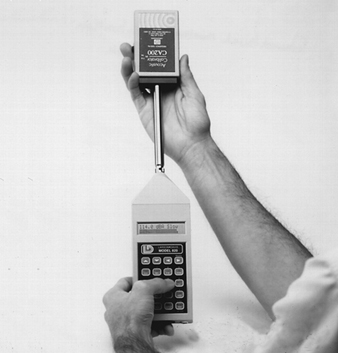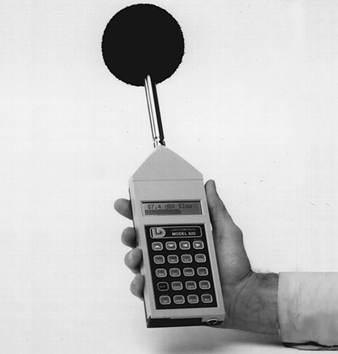For the prevention of adverse effects of noise on workers, attention should be paid to the choice of appropriate instrumentation, measuring methods and procedures for evaluating workers’ exposures. It is important to evaluate correctly the different types of noise exposures, such as continuous, intermittent and impulse noise, to distinguish noise environments with differing frequency spectra, as well as to consider the variety of working situations, such as drop-forge hammering shops, rooms housing air compressors, ultrasonic welding processes, and so forth. The main purposes of noise measurement in occupational settings are to (1) identify overexposed workers and quantify their exposures and (2) assess the need both for engineering noise control and the other types of control that are indicated. Other uses of noise measurement are to evaluate the effectiveness of particular noise controls and to determine the background levels in audiometric rooms.
Measuring Instruments
Instruments for noise measurement include sound level meters, noise dosimeters and auxiliary equipment. The basic instrument is the sound level meter, an electronic instrument consisting of a microphone, an amplifier, various filters, a squaring device, an exponential averager and a read-out calibrated in decibels (dB). Sound level meters are categorized by their precision, ranging from the most precise (type 0) to the least (type 3). Type 0 is usually used in the laboratory, type 1 is used for other precision sound level measurements, type 2 is the general purpose meter, and type 3, the survey meter, is not recommended for industrial use. Figure 1 and figure 2, illustrate a sound level meter.
Figure 1. Sound level meter—calibration check. Courtesy of Larson Davis
Figure 2. Sound level meter with wind screen. Courtesy of Larson Davis
Specifications for sound level meters may be found in national and international standards, such as the International Organization for Standardization (ISO), the International Electrotechnical Commission (IEC) and the American National Standards Institute (ANSI). The IEC publications IEC 651 (1979) and IEC 804 (1985) pertain to sound level meters of types 0, 1, and 2, with frequency weightings A, B, and C, and “slow,” “fast” and “impulse” time constants. ANSI S1.4-1983, as amended by ANSI S1.4A-1985, also provides specifications for sound level meters.
To facilitate more detailed acoustical analysis, full octave-band and 1/3 octave-band filter sets may be attached to or included in modern sound level meters. Nowadays, sound level meters are becoming increasingly small and easy to use, while at the same time their measurement possibilities are expanding.
For measuring non-steady noise exposures, such as those that occur in intermittent or impulse noise environments, an integrating sound level meter is most convenient to use. These meters can simultaneously measure the equivalent, peak and maximum sound levels, and calculate, log and store several values automatically. The noise dose meter or “dosimeter” is a form of integrating sound level meter that can be worn in the shirt pocket or attached to the worker’s clothing. Data from the noise dosimeter may be computerized and printed out.
It is important to make sure that noise measuring instruments are always properly calibrated. This means checking the instrument’s calibration acoustically before and after each day’s use, as well as making electronic assessments at appropriate intervals.
Measurement Methods
The noise measurement methods to be used depend on the measurement objectives, namely, to assess the following:
- the risk of hearing impairment
- the need for and appropriate types of engineering controls
- the “noise load” for compatibility with the type of job to be performed
- the background level necessary for communication and safety.
International standard ISO 2204 gives three types of method for noise measurement: (1) the survey method, (2) the engineering method and (3) the precision method.
The survey method
This method requires the least amount of time and equipment. Noise levels of a working zone are measured with a sound level meter using a limited number of measuring points. Although there is no detailed analysis of the acoustic environment, time factors should be noted, such as whether the noise is constant or intermittent and how long the workers are exposed. The A-weighting network is usually used in the survey method, but when there is a predominant low-frequency component, the C-weighting network or the linear response may be appropriate.
The engineering method
With this method, A-weighted sound level measurements or those using other weighting networks are supplemented with measurements using full octave or 1/3 octave-band filters. The number of measuring points and the frequency ranges are selected according to the measurement objectives. Temporal factors should again be recorded. This method is useful for assessing interference with speech communication by calculating speech interference levels (SILs), as well as for engineering noise abatement programmes and for estimating the auditory and non-auditory effects of noise.
The precision method
This method is required for complex situations, where the most thorough description of the noise problem is needed. Overall measurements of sound level are supplemented with full octave or 1/3 octave-band measurements and time histories are recorded for appropriate time intervals according to the duration and fluctuations of the noise. For example, it may be necessary to measure peak sound levels of impulses using an instrument’s “peak hold” setting, or to measure levels of infrasound or ultrasound, requiring special frequency measuring capabilities, microphone directivity, and so forth.
Those who use the precision method should make sure that the instrument’s dynamic range is sufficiently great to prevent “overshoot” when measuring impulses and that the frequency response should be broad enough if infrasound or ultrasound is to be measured. The instrument should be capable of making measurements of frequencies as low as 2 Hz for infrasound and up to at least 16 kHz for ultrasound, with microphones that are sufficiently small.
The following “common sense” steps may be useful for the novice noise measurer:
- Listen for the main characteristics of the noise to be measured (temporal qualities, such as steady-state, intermittent or impulse qualities; frequency characteristics, such as those of wide-band noise, predominant tones, infrasound, ultrasound, etc.). Note the most prominent characteristics.
- Choose the most suitable instrumentation (type of sound level meter, noise dosimeter, filters, tape recorder, etc.).
- Check the instrument’s calibration and performance (batteries, calibration data, microphone corrections, etc.).
- Make notes or a sketch (if using a system) of the instrumentation, including model and serial numbers.
- Make a sketch of the noise environment to be measured, including major noise sources and the size and important characteristics of the room or outdoor setting.
- Measure the noise and note down the level measured for each weighting network or for each frequency band. Also note the meter response (such as “slow,” “fast,” “impulse,” etc.), and note the extent to which the meter fluctuates (e.g., plus or minus 2 dB).
If measurements are made outdoors, pertinent meteorological data, such as wind, temperature and humidity should be noted if they are considered important. A windscreen should always be used for outdoor measurements, and even for some indoor measurements. The manufacturer’s instructions should always be followed to avoid the influence of factors such as wind, moisture, dust and electrical and magnetic fields, which may affect the readings.
Measuring procedures
There are two basic approaches to measuring noise in the workplace:
- The exposure of each worker, worker type or worker representative may be measured. The noise dosimeter is the preferable instrument for this purpose.
- Noise levels may be measured in various areas, creating a noise map for the determination of risk areas. In this case, a sound level meter would be used to take readings at regular points in a coordinate network.
Worker Exposure Evaluation
To assess the risk of hearing loss from specific noise exposures, the reader should consult the international standard, ISO 1999 (1990). The standard contains an example of this risk assessment in its Annex D.
Noise exposures should be measured in the vicinity of the worker’s ear and, in assessing the relative hazard of workers’ exposures, subtractions should not be made for the attenuation provided by hearing protection devices. The reason for this caveat is that there is considerable evidence that the attenuation provided by hearing protectors as they are worn on the job is often less than half the attenuation estimated by the manufacturer. The reason for this is that the manufacturer’s data are obtained under laboratory conditions and these devices are not usually fitted and worn so effectively in the field. At the moment, there is no international standard for estimating the attenuation of hearing protectors as they are worn in the field, but a good rule of thumb would be to divide the laboratory values in half.
In some circumstances, especially those involving difficult tasks or jobs requiring concentration, it may be important to minimize the stress or fatigue related to noise exposure by adopting noise control measures. This may be true even for moderate noise levels (below 85 dBA), when there is little risk of hearing impairment, but the noise is annoying or fatiguing. In such cases it may be useful to perform loudness assessments using ISO 532 (1975), Method for Calculating Loudness Level.
Interference with speech communication may be estimated according to ISO 2204 (1979) using the “articulation index”, or more simply by measuring the sound levels in the octave bands centred at 500, 1,000 and 2,000 Hz, resulting in the “speech interference level”.
Exposure criteria
The selection of noise exposure criteria depends on the goal to be attained, such as the prevention of hearing loss or the prevention of stress and fatigue. Maximum permissible exposures in terms of daily average noise levels vary among nations from 80, to 85, to 90 dBA, with trading parameters (exchange rates) of 3, 4, or 5 dBA. In some countries, such as Russia, permissible noise levels are set anywhere from 50 to 80 dBA, according to the type of job performed and taking into account the mental and physical work load. For example, the allowable levels for computer work or the performance of demanding clerical work are 50 to 60 dBA. (For more information on exposure criteria, see the article “Standards and regulations” in this chapter.)

